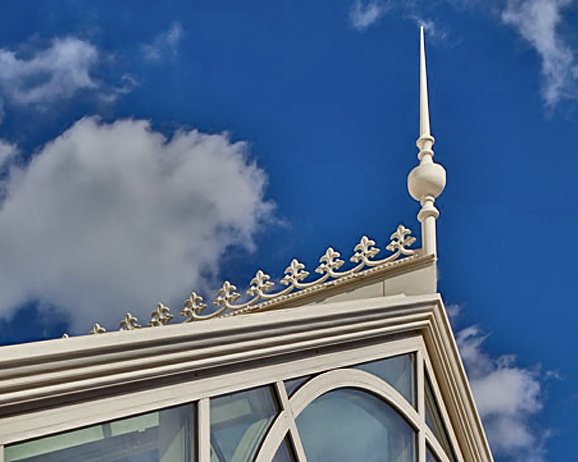Decorative Finials
Finials are an old form of detailing in many architectural designs. Ornate headboards and railings often have finials, drapes and chandeliers can have finials, and garden finials are also very popular in outdoor décor. Many homes in the United States also still use finials today. Antique and modern finials are brass, wood, and wrought iron. Either, classic or traditional homes use finials on the home’s exterior and interior. Finials produced by Solar Innovations® are constructed out of cast aluminum or copper, and utilize on outdoor structures, including conservatories, greenhouses, pool enclosures, and sunrooms. Also a finial is an affordable way to add charm to any structure.
There are varying styles and heights of finials available through Solar Innovations®. In cast aluminum, there are also seven fleurs-de-lis available along with six ball and spire combinations. The ball and spire combinations can be matched in different pairs to create a custom finial unique to your specific project. Another great aspect of the ball and spires is the ability to act as a lightning rod. This is done by threading the finial and then connecting to the ground wire.

Finials as Lightning Rods
Most finials, with at least a minimum thickness of 3/16″, can be a lightning rod. Solar Innovations® recommends a full lightning protection system for all structures. Therefore, customers should bond the metal structure to its own earth-ground or tie it directly to an existing building’s grounding system.
Lightning Protection
Lightning protection is also, a subject often misunderstood in the construction industry. It, as a result, may require a subjective decision based on an examination of the relative critical nature of the structure’s location and its contents. Architects and engineers take site specific lightning flash density into consideration to finally determine the lightning protection.
Grounding Systems
Use aluminum or copper for grounding systems. Copper is normally considered the better choice for electrical grounding because it is a better conductor than aluminum. As a result, this allows for the use of a smaller cable; however, when installed in an aluminum structure, there are concerns with dissimilar metal properties. This can also be avoided by using aluminum components within the Solar Innovations® system and then converting with the appropriate isolation component outside of the structure to copper and finally terminating it at a ground rod location.




